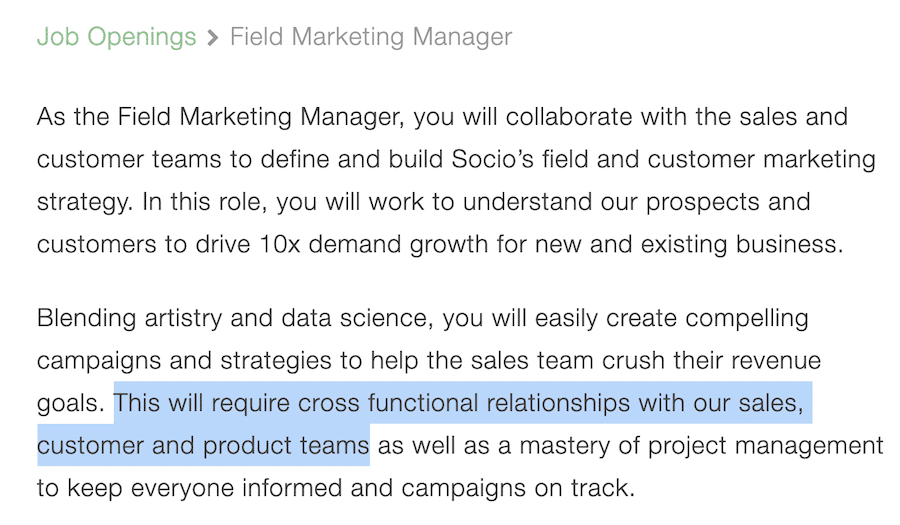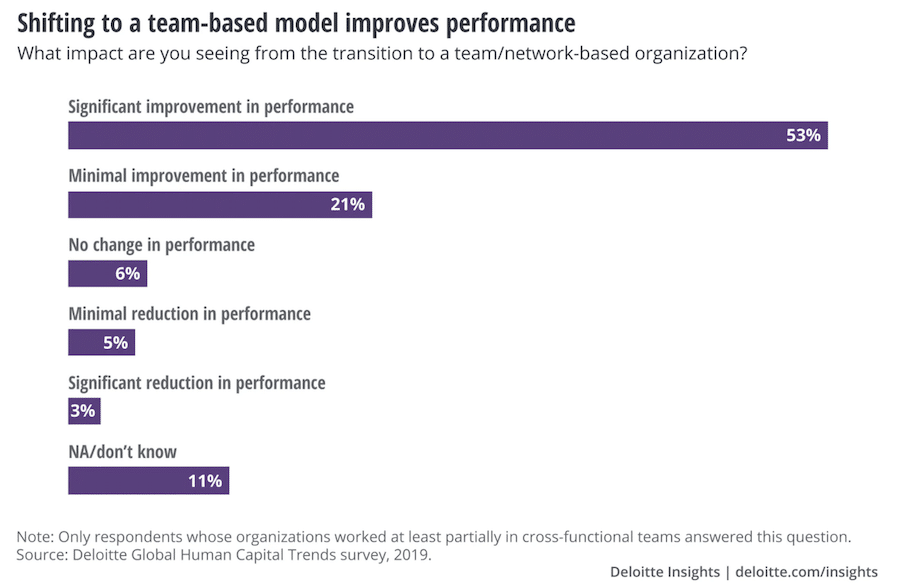You’ve been there.
Your business has multiple teams that have grown and succeeded independently of each other. They’ve developed their own internal standard operating procedures—their own habits and processes to complete their work.
But you begin to realize that these teams are losing touch with each other. Work is getting repeated in multiple places, and slowly the broader company goals have drifted away from narrower department-specific goals.
Innovation is being replaced with statements of “because this is how we’ve always done it.”
This is the slow silo effect that happens within many businesses as they grow. Teams begin to develop their unique way of doing things that become more and more distinct from the broader company and turn the company into a group of departmental “silos.”
Now, the answer that many turn to—and rightly so—is to build a cross-functional collaborative team. Why? Because projects with strong cross-functional collaboration or executive support have a 76% success rate, according to Stanford-based transformational leadership expert Behnam Tabrizi.1 But success drops to 19% when projects have only moderate cross-functional support.
Unfortunately, this process isn’t easy. Building a cross-functional collaborative team can seem simple, but there are many small details that can make or break their success.
And that’s why, in this article, we’re going to explore cross-functional collaboration from top to bottom, from defining what it is to how you can implement it effectively. We’ll look at:
- What cross-functional collaboration is
- How remote work impacts cross-team collaboration
- A framework for doing it effectively
- The various barriers to doing cross-functional collaboration well—and how to overcome them
- 3 cross-functional examples from real teams
🔑 Spoiler alert: a powerful communication tool is one key to better collaboration. Grab the free checklist to help you choose the right one for your business.
What exactly is cross-functional collaboration?
Cross-functional collaboration, as its name suggests, is when individuals across different teams in a business form a new team around a new goal. This can be a short-term (for a specific project) or long-term (for an ongoing growth strategy) arrangement.
The ability to work cross-functionally is highly valued, so much so that employers specify it in job postings. Take this field marketing manager role posted by event platform Socio:

Cross-functional collaboration may be a short- or long-term effort, depending on the business need. For instance, a field marketing manager like the one above might lead a cross-functional event team who would recommend which conferences and trade shows the company should exhibit at. The team might look something like this:
- Field marketing manager: Assesses and presents top event opportunities, prepares budgets, and handles logistics
- Sales director: Weighs in on each event’s lead potential and decides which sales reps and account executives to send
- Product manager: Helps optimize product presentation and plans how on-site demos will happen at the booth
- Customer service manager: Identifies existing customers who’ll be there for nurturing and upsell opportunities
To measure their success, cross-functional teams may track different metrics than what they do in their day-to-day roles. For instance, a product launch team may prioritize free trial sign-ups over closed-won deals, believing that those trials will convert at a higher annual contract value (ACV) in a few months.
In any case, the fundamental philosophy behind cross-functional collaboration is that businesses work better when every team is working toward the same big goals and everyone has clarity about their roles and responsibilities in accomplishing that mission.
What’s so important about cross-functional collaboration?
As businesses grow, it’s natural for individual groups within them to slowly form into silos. Over time, those silos develop their own habits and goals. What once appeared as one unified company and brand can slowly end up looking fragmented.
In many cases, when communication isn’t as good as it should be, different teams within the same business can slowly begin working on goals that are at odds with each other (or at least not pulling in the same direction as effectively).
Cross-functional collaboration creates clarity in your business’s goals and rallies focus around your customers’ needs, leading to better products and more revenue.
In short, without cross-functional collaboration, a business—even if it’s a small business—can become less and less efficient over time.
There are three chief reasons cross-functional collaboration does this:
- It puts you closer to your customers. The Startup observes that, as more companies adopt product-led growth, “successful organizations do not want developers guessing their customer needs.”2 This leads to cross-functional teams forming around the customer, creating tight feedback loops that benefit multiple departments. Dev builds faster, marketing creates messaging faster, and sales grasps pain points faster.
- It combats the silo effect. The silo effect refers to departments gradually isolating from each other. When that happens, departments stop pulling in the same direction, or they may even work on goals at odds with each other. But as Trello notes, meaningful collaboration between employees with different skill sets establishes long-term lines of communication.3 Cross-functional collaboration helps departments realize they depend on each other for success.
- It supports healthy brand management. The fewer silos there are in place, the more ideas flow freely from employee to employee, team to team, and department to department. This open exchange of ideas is vital to brand management, according to Frontify.4 Cross-functional collaboration broadens everyone’s perspective so the brand evolves. At the same time, it keeps individual ideas from diluting the brand experience.
Basically, cross-functional collaboration can improve business clarity across teams and ultimately, lead to greater results and revenue.
How remote work impacts cross-team collaboration
Remote work presents several challenges for fast, agile cross-functional collaboration. Today, speed and agility are more important than ever for a business’s success. About 30,000 new consumer products come out each year, but 95% fail.5 The pressure is on to be part of the 5% that succeed.
One of the biggest challenges remote cross-functional teams face is distance, and not just physical distance. In fact, Harvard Business Review (HBR) defines three types of distance remote teams must overcome: physical, operational, and affinity.6 Of these three, affinity distance is most important.7 It encompasses the differences in culture, communication style, and hierarchy that often prevent team members from building a shared sense of fate.
The right communication tools and strategy help close affinity distance. For instance, regular video meetings connect team members face-to-face, helping them to see each other as people and not just so-and-so from another department. Likewise, dedicated messaging channels help cross-functional teams cut through the noise and stay focused on moving projects forward together.
But remote work also presents an advantage to cross-functional collaboration. Remote workplaces tend to flatten hierarchy a bit. This seems like good news, given Deloitte’s findings that: “The shift from hierarchies to cross-functional teams is well underway. Our data shows that adopting team structures improves organizational performance for those that have made the journey; organizations that have not risk falling further behind.”8

In fact, Deloitte’s research on organizations that move to cross-functional teams found that 53% experienced a significant improvement in performance, and 31% reported that most or almost all of their work was being done in teams.
What teams need to work cross-functionally
As we can see in the section above, cross-functional collaboration isn’t wildly different for remote teams than for those at the office. However, understanding those differences can’t be underestimated. HBR reports that 75% of cross-functional teams are dysfunctional because they fail in at least three of five areas:9
- Meeting a planned budget
- Staying on schedule
- Adhering to specifications
- Meeting customer expectations
- Maintaining alignment with company goals
Often, teams fail in these areas because they don’t create sufficient clarity around who is in charge, what the team is accountable for, and which goals must be focused on. Here are three things to give your remote cross-functional teams so they have the clarity to consistently deliver positive results:
- Empowered leadership: Yes, remote workplaces do flatten hierarchy some, and that helps teams create an identity faster. Still, each cross-functional team needs a clear leader so accountability is understood. If a project falls off course, find a way to refocus the team around its leader. Say a content marketing manager is having trouble getting the sales, customer, and product departments to give input on a monthly editorial calendar. A director or executive can lend their voice to the conversation, clarifying the hierarchy and how the leader is to be supported.
- Lean teams: Cross-functional collaboration often operates like a delegation. Members may work individually, but they may also take work back to their departments and assimilate it into their existing workload. Keeping your teams lean and equipped with the right remote working tools makes it easier to track who is accountable for what.
- Everything documented: Documenting as much as possible is critical to remote team success. First, it sets expectations that can be referenced at any time. Second, it tracks progress and key learnings, making it easier for cross-functional teams to iterate. For instance, a growth team might notice that brand mentions correspond with the biggest influxes of leads, leading to more investment in brand-building campaigns.
Watch out for these barriers to cross-functional collaboration
Don’t let problems that are easy to anticipate derail your employees from working cross-functionally together. Be on the lookout for these common culprits that can ruin teamwork:
- Problem: A lack of trust. A lack of trust gets in the way of effective collaboration in the workplace. As trust decreases, vulnerability and uncertainty increase, making teams reluctant to share and work through problems.10
- Possible solution: Practice collaborative leadership by emphasizing transparency and listening. Also help team members forge relationships with tactics like virtual team-building activities.
- Problem: Social loafing. Remember in high school when you had a group project, and there was always someone on the team who coasted through without contributing much, if anything? That’s social loafing, and it happens in business teams too.
- Possible solution: Keep cross-functional teams small and responsibilities specific so there’s no mystery surrounding accountability. Also make sure that when recruiting members for a cross-functional team, there’s strong alignment between skills and goals so everyone feels confident doing their part. Build feedback loops, too, like regular 10-minute check-ins to spot and address issues sooner than later.
- Problem: Poor communication. Poor communication alone sinks one-third of projects.11 A good rule of thumb: aim to overcommunicate so you prevent a lack of communication from ever happening.
- Possible solution: Unite remote team members through a central collaboration hub or video conferencing tools that bring different communication channels together in one place. That way, teams don’t have to switch apps just to talk to each other. Making team communication rhythmic helps, too, such as scheduling a weekly kickoff.
- Problem: Misaligned goals and objectives. This typically happens because there isn’t clear, strong leadership behind a cross-functional team. That creates haziness around who’s accountable for what.
- Possible solution: Refocus on the leader so everyone is in alignment. Make sure your project management tools are adequate, too. They should help you easily assign tasks, track due dates, and give the entire team project visibility. RingCentral’s team messaging lets you assign tasks straight from your conversations:

In RingCentral’s desktop and mobile apps, you can assign tasks to teammates in your group messaging thread so that everyone can easily stay on track and keep each other accountable.
- Problem: Divergent technologies. This happens when everyone brings their own tools to the project. This can easily happen with cross-functional collaboration because different departments may use different software.
- Possible solution: Identify what collaboration tools are crucial for the project and which options are most accessible. For example, if three departments use Google Docs, but one uses Notion, it’s probably best to go with Google Docs. That way, you’re choosing the tools that give the team its best chance for success.
One of the main perks of sharing that team knowledge is that if an employee does resign one day, it’s easier to fill that gap because that person wasn’t the only one in the company who knew how to do a certain thing.
3 cross-functional team examples
Want some examples of how companies have used cross-functional collaboration to deliver business results? Here are three stories to inspire you.
1. GrowthHackers
First, GrowthHackers details how Capital One built a cross-functional team to support its CreditWise monitoring app.12 Pranav Khanna, VP of product and analytics for the project, recognized CreditWise hit a point in its product life cycle where retention and revenue had become as important as user acquisition. By uniting employees from product, design, engineering, marketing, and data, Khanna built a team that expanded CreditWise’s growth to a full AARRR funnel (acquisition, activation, retention, revenue, referral).
2. Auth0
A second example is how Auth0 redesigned its homepage through cross-team collaboration.13 The project became a priority when internal testing revealed that 40% of visitors didn’t know what Auth0 did after seeing its homepage. So Auth0 pulled together a team with members from growth, marketing, content, and UI engineering to redesign the homepage. After some A/B testing, Auth0 found a design with a CTA that converted 39% more form-fills:

3. Asana
Third, Asana shares how InVision relies on cross-functional collaboration to create impactful marketing campaigns.14 The 100%-remote company starts campaigns through tight collaboration between its marketing and product teams. From there, they involve the executive. They even involve the whole company when it comes to launch campaigns for new products or features, using those internal reactions to see what insights bubble up.
Support remote cross-functional collaboration with the right tools
Ultimately, cross-functional collaboration is unique to every business, so flex and adapt the tips from this guide to how they work best for your teams. Picking the right tools makes this much easier, especially communication tools that let your team to collaborate from anywhere.
Looking for a tool that can help facilitate this type of teamwork in your business? Check out RingCentral’s desktop and mobile apps, which bring together team messaging, a phone service, and video conferencing—all in the same place to give your team multiple channels to collaborate on.
1 hbr.org/2015/06/75-of-cross-functional-teams-are-dysfunctional
2 medium.com/swlh/collaborating-effectively-in-cross-functional-product-team-settings-5e08ee6057b8
3 blog.trello.com/tips-to-improve-cross-team-collaboration
4 frontify.com/en/blog/why-cross-functional-collaboration-is-vital-to-brand-management
5 hbswk.hbs.edu/item/clay-christensens-milkshake-marketing
6 hbr.org/2018/02/how-to-collaborate-effectively-if-your-team-is-remote
7 hbr.org/2012/09/three-symptoms-of-a-vulnerable-team
8 www2.deloitte.com/us/en/insights/focus/human-capital-trends/2019/team-based-organization.html
9 hbr.org/2015/06/75-of-cross-functional-teams-are-dysfunctional
10 scienceforwork.com/blog/trust-impact-team-performance
11 info.coreworx.com/blog/pmi-study-reveals-poor-communication-leads-to-project-failure-one-third-of-the-time
12 blog.growthhackers.com/building-a-cross-functional-growth-team-at-capital-one-5df93d39b1ee
13 auth0.com/blog/design-driven-by-metrics-and-cross-team-collaboration/#First-Things-First–Cross-Team-Collaboration
14 blog.asana.com/2017/09/invision-process-execute-great-marketing-campaigns
Originally published Oct 16, 2020, updated Mar 04, 2024



